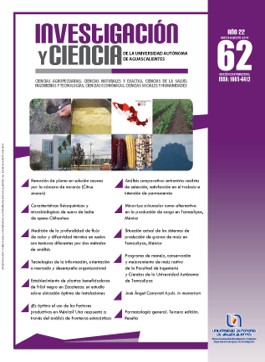Comparative analysis: realistic job interviews, job satisfaction and intention to stay
DOI:
https://doi.org/10.33064/iycuaa2014623635Keywords:
realistic job interview, job satisfaction, ntention to stay, Human resource managementAbstract
This research extends the study of Littlewood, Flores, Castañeda and Mercado (2005) which compares variables as realistic job interviews (ERS), job satisfaction (ST) and intention to stay in the organization (IP) by using a sample of 162 undergraduate students and 258 Postgraduates. The survey has 26 items, obtaining levels of reliability higher than 0.60, finding that in fact there are differences between ERS and IP, but not on the ST level.
Downloads
References
• FLORES, R. y MADERO, S. M. Factores de la calidad de vida en el trabajo como predictoras de la intención de permanencia.
Acta Universitaria, 22(2): 24-31, 2012.
• GRIFFETH, R. W. et al. A meta-analysis of antecedents and correlates of employee turnover: Updates, moderator tests, and research implications for the next millennium. Journal of Management, 26, 463-470, 2000.
• HADEN, S. Realistic Job Previews and Performance: The Mediating Influence of Personal Goals. Journal of Management Research, 12 (3): 163-178, 2012.
• HOM, P. y GRIFFETH, R. W. Structural equations modeling test of a turnover theory cross-sectional and longitudinal analysis. Journal of Applied Psychology, 76, 350-366, 1991.
• HOM, P. y GRIFFETH, R. W. et al. An exploratory investigation into theorical mechanisms underlying realistic job previews. Personnel Psychology, 51 421-451, 1998.
• HURST, J. et al. Conversion intentions of interns: what are the motivating factors? Education & Training, 54(6): 504-522, 2012.
• JAROS, S. J. An assessment of Meyer and Allen´s (1991) three-component model of organizational commitment and turnover intentions. Academy of Management Journal, Best Papers Proceedings, 317-335, 1995.
• KAMMEYER-MUELLER, J. D. y WANBERG, C. R. Unwrapping the organizational entry process: Disentangling multiple antecedents and their pathways to adjustment. Journal of Applied Psychology, 88(5): 779-794, 2003.
• LITTLEWOOD, H. et al. Entrevista de Selección, Satisfacción en el trabajo e Intención de permanencia. X Foro de Investigación UNAM, México, D. F., 2005.
• LOCKE, E. A. The nature and cause of job satisfaction. In DUNNETE, M. M. (Ed.), Handbook of Industrial and Organizational Psychology, Chicago: Rand McNally, 1976.
• LOCKE, E. A. The ubiquity of the technique of goal setting in theories of and approaches to employee motiviation. Academy of Management, 3(3): 594-601, 1978.
• MEGLINO, B. M. y DeNISI, A. S. Realistic Job Previews: Some Thoughts on Their More Effective Use in Managing the Flow of Human Resources. HR. Human Resource Planning, 10(3): 157-167, 1987.
• MEGLINO, B. et al. Effects of previous job exposure and subsequent job status on the functioning of a realistic job preview. Personnel Psychology, 46(4): 803-822, 1993.
• MEGLINO, B. et al. Effects of realistic job previews: A comparison using an enhancement and a reduction preview. Journal of Applied Psychology, 73(2): 259-266, 1988.
• MEGLINO, B. et al. When does it hurt to tell the truth? The effect of realistic job reviews on employee recruiting. Public Personnel Management, 26(3): 413-422, 1997.
• PAILLÉ, P. Perceived Stressful Work, Citizenship Behaviour and Intention to Leave the Organization in a High Turnover Environment: Examining the Mediating Role of Job Satisfaction. Journal of Management Research, 3(1): 1-16, 2011.
• PATTNAIK, S. y SAHOO, R. Does Pre-Selection Information to Job Candidates Affect Post-Selection Intention to Leave?International Journal of Management Research and Reviews, 2(12): 2040-2048, 2012.
• POPOVICH, P. y WANOUS, J. P. The realistic job preview as a persuasive communication. Academy of Management, 7(4): 570-578, 1982.
• PREMACK, S. L. y WANOUS, J. P. A meta-analysis of realistic job preview experiments. Journal of Applied Psychology, 70(4): 706-719, 1985.
• RIORDAN, C. M. et al. The effects of pre-entry experiences and socialization tactics on newcomer attitudes and turnover. Journal of Managerial Issues, 13(2): 159-176, 2001.
• SCURRY, T. y BLENKINSOPP, J. Under-employment among recent graduates: a review of the literature. Personnel Review, 40(5): 643-659, 2011.
• SHAHID, A. y AZHAR, S. M. Gaining Employee Commitment: Linking to Organizational Effectiveness. Journal of Management Research, 5(1): 250-268, 2013.
• TETT, R. P. y MEYER, J. P. Job satisfaction, organizational commitment, turnover intention, and turnover: Path analysis based on meta-analytical findings. Personnel Psychology, 46, 259-265, 1993.
• WANOUS, J. P. Installing A Realistic Job Preview: Ten Tough Choices. Personnel Psychology, 42(1): 117-134, 1989.
Downloads
Published
How to Cite
License
Copyright (c) 2014 Sergio Manuel Madero Gómez, Ricardo Flores Zambada, Herman Frank Littlewood Zimmerman, Antonio Castañeda Ríos, Patricia Mercado Salgado

This work is licensed under a Creative Commons Attribution-NonCommercial-ShareAlike 4.0 International License.
Las obras publicadas en versión electrónica de la revista están bajo la licencia Creative Commons Atribución-NoComercial-CompartirIgual 4.0 Internacional (CC BY-NC-SA 4.0)









